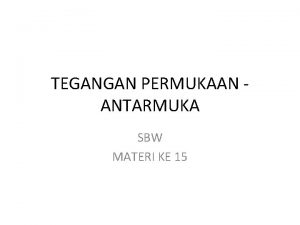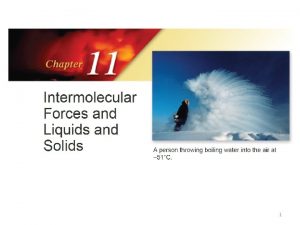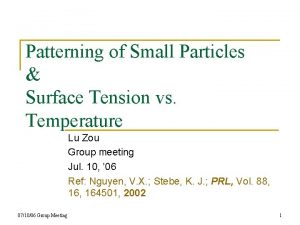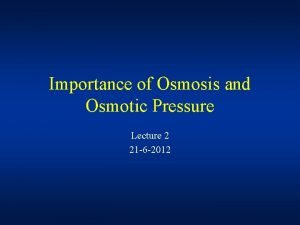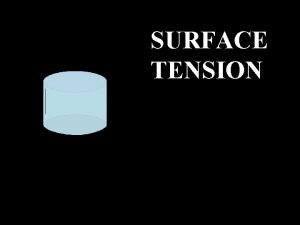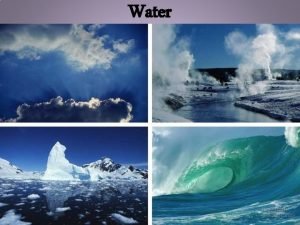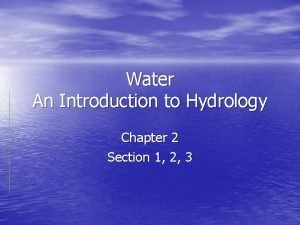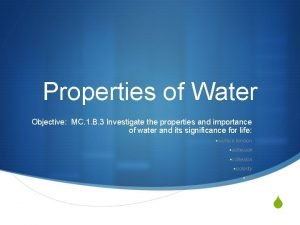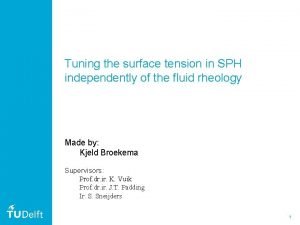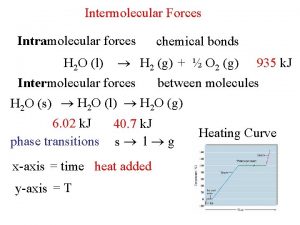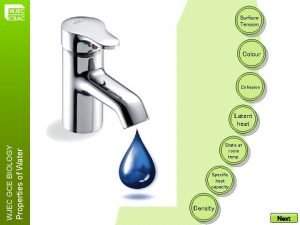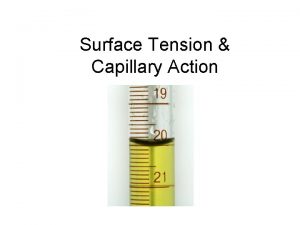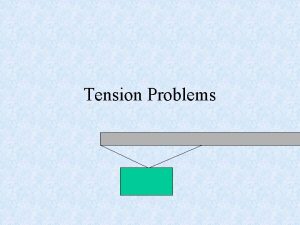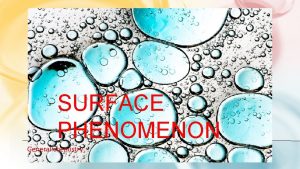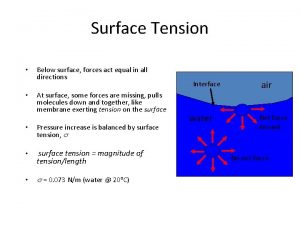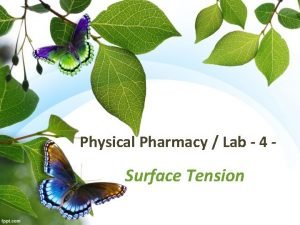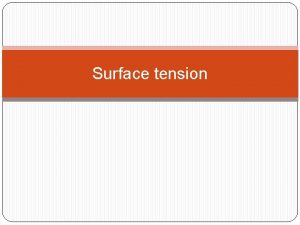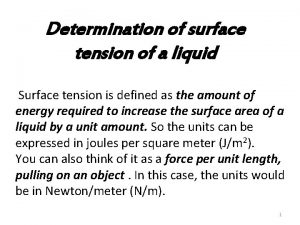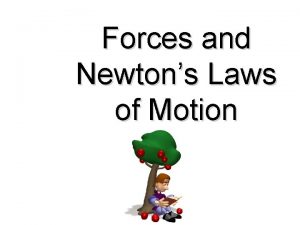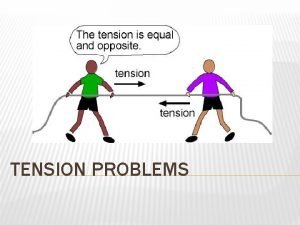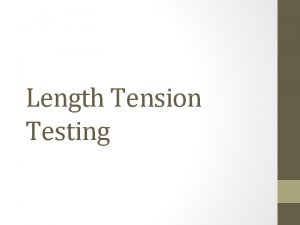11 4 11 5 Grace Levine Surface Tension

















- Slides: 17

11. 4 -11. 5 Grace Levine

Surface Tension ★liquids tend to minimize their surface area ★ In order to increase the surface area of the liquid, molecules from the interior have to be moved to the surface, and, because molecules at the surface have a higher potential energy than those in the interior, this movement requires energy. Therefore, instead, liquids tend to minimize their surface area ○ As a result, its surface behaves like a “skin. ”

Surface Tension Continued…. . ★The surface tension of a liquid is the energy required to increase the surface area by a unit amount ○ For example: at room temperature, water has a surface tension of 72. 8 m. J/m^2, so it takes 72. 8 m. J to increase the surface area of water by one square meter ★Surface tension decreases as intermolecular forces decrease Why do you think water has a high surface tension?

Viscosity ★Viscosity: the resistance of a liquid to flow ○ Measured in poise (P), which is defined as 1 g/cm x s ★Viscosity is greater in substances with strong intermolecular forces because if molecules are more strongly attached to each other, they do not flow around each other as freely ★Viscosity depends on molecular shape, increasing in longer molecules that can interact over a greater area and possibly become entangled

Capillary Action ★Capillary action is the ability of a liquid to flow against gravity up a narrow tube ★Results from the attraction between molecules in a liquid, called cohesive forces, and the attraction between these molecules and the surface of the tube, called adhesive forces ○ If the adhesive forces are greater than the cohesive forces, the attraction to the surface draws the liquid up the tube and the cohesive forces pull along those molecules not in direct contact with the tube walls ○ If the adhesive forces are smaller than the cohesive forces , the liquid does not rise up the tube at all

The Process of Vaporization ★Vaporization: transition from liquid to gas (opposite: condensation) ○ The rate of vaporization increases with increasing temperature ○ The rate of vaporization increases with increasing surface area ○ The rate of vaporization increases with decreasing strength of intermolecular forces ★Volatile: liquids that vaporize easily ★Nonvolatile: liquids that do not vaporize easily

The Energetics of Vaporization ★Vaporization is an endothermic process ○ Vaporization requires overcoming the IMF’s that hold liquids together. Since energy is needed to pull the molecules away from one another, the process is endothermic. ★Condensation is an exothermic process

Heat of Vaporization ★The amount of energy required to vaporize one mole of liquid to gas ○ Always positive because vaporization is endothermic ○ When a gas condenses to a liquid, the same amount of heat is involved from when it vaporizes, but the number is negative

Practice Problem! Calculate the mass of water (in g) that can be vaporized at its boiling point with 155 k. J of heat( the heat of vaporization of water is 40. 7 k. J/mol at 100 degrees C). ★ KJ→ mol H 20→ g H 20 ★ 18. 02 g H 20 = 1 mol H 2 O ★ 1. 55 k. J x 1 mol H 20/ 40. 7 k. J x 18. 02 g H 2 O/ 1 mol H 20= 68. 6 g H 20

Vapor Pressure and Dynamic Equilibrium (a)When water is in a sealed container, water molecules begin to vaporize. (b)As water molecules build up in the gas state, they begin to recondense into the liquid. (c) When the rate of evaporation equals the rate of condensation, dynamic equilibrium is reached. ★ Vapor pressure is the pressure of a gas in dynamic equilibrium with its liquid ○ Depends on IMF’s present in the liquid and the temperature ○ Weak IMF’s result in volatile substances w/ high vapor pressures ○ Strong IMF’s result in nonvolatile substances w/ low vapor pressures

Dynamic Equilibrium Continued. . . ★When a system in dynamic equilibrium is disturbed, the system responds so as to minimize the disturbance and return to a state of equilibrium. (a)Liquid n-pentene is in dynamic equilibrium with its vapor. (b)When the volume is increased, the pressure drops and some liquid is converted to gas to bring the pressure back up. (c) When the volume is decreased, the pressure increases and some gas is converted to liquid to bring the pressure back down.

Practice Problem! What happens to the vapor pressure of a substance when its surface area is increased at constant temperature? (a) The vapor pressure increases. (b) The vapor pressure remains the same. (c) The vapor pressure decreases. Answer: B With a larger surface area, that means more liquid water molecules are on the surface and can escape into the gas phase, but proportionately more of the vapor molecules will condense back into a liquid so there is no change in vapor pressure.

Practice Problem! Which property of a liquid increases with increasing temperature? (a)Surface tension (b)Viscosity (c)Vapor pressure Answer: C (d)None of the above

Boiling Point ★Boiling point of a liquid is the temperature at which its vapor pressure equals the external pressure ★Molecules in the interior of the liquid, not just those on the surface, break free and enter the gas state ★When water boils the bubbles are pockets of gaseous water that have formed in the liquid water. ★Strong IMF’s between particles lead to high boiling points and, consequently, low vapor pressures

Practice Problem! Which compound would you expect to have greater surface tension: acetone [(CH 3)2 CO] or water (H 2 O)? Explain. Water: Surface tension increases with increasing intermolecular forces, and water can hydrogen bond while acetone cannot.

Practice Problem! Spilling room-temperature water over your skin on a hot day cools you down. Spilling room-temperature vegetable oil over your skin on a hot day does not. Explain the difference. Water is more volatile than vegetable oil. When the water evaporates, the endothermic process results in cooling.

Practice Problem! Which evaporates more quickly: 55 m. L of water in a beaker with a diameter of 4. 5 cm, or 55 m. L of water in a dish with a diameter of 12 cm? Is the vapor pressure of the water different in the two containers? Explain. The water in the 12 cm dish will evaporate more quickly. The vapor pressure does not change but the surface area does. The water in the dish evaporates more quickly because the greater surface area allows for more molecules to obtain enough energy at the surface and break free.
 High surface tension vs low surface tension
High surface tension vs low surface tension Energi bebas permukaan
Energi bebas permukaan Transference meaning psychology
Transference meaning psychology Once in grace always in grace
Once in grace always in grace Sanctifying grace vs actual grace
Sanctifying grace vs actual grace Shout grace grace to the mountain
Shout grace grace to the mountain Shampoo colloid type
Shampoo colloid type Surface tension intermolecular forces
Surface tension intermolecular forces Surface tension vs temperature
Surface tension vs temperature Osmolality vs osmolarity
Osmolality vs osmolarity Surface tension meaning
Surface tension meaning Whats capillary action
Whats capillary action Surface tension
Surface tension How does the property of water support fish in general
How does the property of water support fish in general Sph surface tension
Sph surface tension Surface tension intermolecular forces
Surface tension intermolecular forces How does water purity affect surface tension hypothesis
How does water purity affect surface tension hypothesis What is surface tension biology
What is surface tension biology

